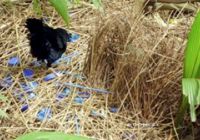The first thing that struck me when birding in Australia some years ago was the numerous species of aquatic birds that could easily be observed at ease at their rivers, ponds, lakes, swamps, rock edges, wetlands and seaside.
It is simply too complex to describe the large family order of Gruiformes. Instead, let us focus on just one of the sub-family- Rallidae. This cosmopolitan sub order comprises of rails, gallinules (moorhens, swamphens) and coots, ranging from sparrow-sized (15-16cm) to rooster-size (44-48cm) birds, they alone form sixteen species within which are two vagrants and three endemics.
This makes Australia a great place to be observing water birds.
And do you know that the famous New Zealand’s Takahe Notornis as seen in David Attenborough’s bird documentary series is related to the Swamphens?
My recent visit to Queensland in March coincided with hatchings of several waterbird species. It gave me the opportunity to showcase the endearing care of the Dusky Moorhens (Gallinula tenebrosa) and what it was like to be living on the precarious edge in this harsh and predacious world (top).
What makes this species different from our Common Moorhen (G. chloropus) as seen in Malaysia? While common as it sounds, it is not an aquatic bird that is frequently or easily seen close for they are shy and speed to hiding in reed-vegetation the minute they scent potential predators (left).
While both species look similar at field distance, the Dusky Moorhen is slightly larger without a white line along its flanks and its breeding season is virtually the whole year round.
Attached is an image of a breeding adult, showing colourful and rock candy feet of reddish-orange and bright red frontal shield with yellow tip at its best (right). Non-breeders/post breeders appear to have segmented olive, yellow-orange in their feet looking like they were sporadically dipped in mud.
There are still lots to learn about these birds. In the field, it remains difficult to tell the sex as they appear to look the same and there is no image specifically in current field guides that show otherwise. Much research papers are still in wanting. Perhaps further observation and documentation with ‘ornith-porny’ images of the Dusky Moorhen would be, say a decent start in determining their sex.
For now, let’s visit a small river in Queensland State to observe how they got on with their lives at the mercy of nature’s fury, as they propagated their species in their habitat.
At dawn (0615hrs), a reconnaissance along a river bank provided some interesting observation of a family of three sub-juveniles – Dusky Moorhens. They were seen huddled sleepily together on a vegetation of tattered nest, hung precariously over a boom, just before a stoned bridge. The nest appeared to have been devastated by a sudden flood of swollen, river waters after a dry spell. Half their home washed away (below left).
Further inspection by a parent showed that reinforcement was severely in wanting to keep the three oversized chicks together. It was observed this problem was solved by the parent turning up with restoration material l- what looked like a huge sheet of wet rag, dragged out from the river (above right).
“This will do… I suppose?” said a sympathetic and concerned parent as the green, algae-looking rag was dropped at the denuded nest, or what was left of it (left).
Is parental psyche ingrained into these birds at birth by laws of nature to nurture, to care and show compassion and affection? How did the parent know what to do without prior instruction?
Another observation in a different location of the same species provided great views through my telescope. I chanced a focus onto a pair of Dusky Moorhen Gallinula tenebrosa resting on a rock (below left).
Their attention was drawn to a brownish-black, furry chick with unusual yellow beak, swimming in a large lake of green water vegetation. The chick was adventurously swimming away from its parent or parents, oblivious to the dangers that may be slithering under water and be had for a snack meal (above middle).
“Loo….k! Just look at her…!” cried the nervous sub-adult, Dusky Moorhen Gallinula tenebrosa with grey legs to Rocky, the adult mate beside.
‘Mmm….are you sure that’s one of ours, dear?’ asked Rocky. He was cool.
“Of course. She’s got white chin and throat! ” retorted Rosa. The ‘late stage’ juvenile proceeded to holler out vigorously to the chick to get back to base (above right).
This parental behaviour observed of the adult and sub-adult was further clarified by a more knowledgeable Australian field birder who explained that sub-adults or ‘late-stage’ juveniles do con-sort with adults right through their juvenile stages. That would explain them being observed together.
“Oh, she’ll be alright. Just wanna bit of fun to check out the world, that’s all. After all, weren’t you taken in by my ‘tai chi’ stance on a croc the other day?” uttered Rocky on the croc (above).
“Was that croc real, dear…?” Rosa whispered sweetly.
“What were you thinking otherwise, luv?”
AVIAN WRITER DAISY O’NEILL PENANG MALAYSIA
© ROCKY LIFE ON THE AQUATIC EDGE


















